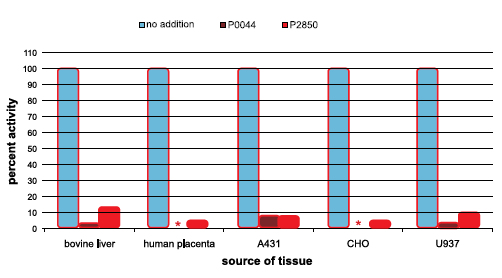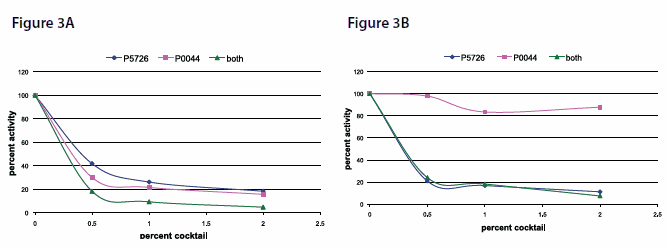Phosphatase Inhibitor Cocktail
Ian Gleiser, Pnina Yaish, Efrat Barnea-Gedalyahu, Dorit Zharhary
Introduction
Phosphorylation is a reversible protein post-translational modification. Protein kinases catalyze the transfer of the negatively charged γ-phosphate group from ATP to a hydroxyl side chain of serine, threonine, or tyrosine residues of the protein, changing the protein’s conformation and activity. The reverse reaction, phosphate removal from the protein, or dephosphorylation, is performed by protein phosphatases.1,2 Three to four percent of mammalian proteins are kinases and phosphatases, some being specific for a few target proteins while others act broadly on many proteins.
Protein phosphorylation is a key regulatory mechanism that controls protein activity, interactions, localization, and degradation. It controls processes of signal transduction, cell cycle, apoptosis, metabolism and others. About one-third of the proteins present in a typical mammalian cell are phosphorylated, many of them on multiple sites. Serine phosphorylation accounts for 86% of the phosphoproteome, while threonine and tyrosine phosphorylation are 12% and 2% respectively. Numerous human diseases are associated with abnormal phosphorylation of cellular proteins.3-5
There are many advantages for a cell to utilize phosphorylation/ dephosphorylation of a protein as a control mechanism. It is rapid, does not require the synthesis of new proteins or degradation of proteins, and is a reversible reaction.
When studying cellular processes involving protein phosphorylation such as signaling cascades and protein-protein interactions, or analysis of phosphorylated sites on a protein and phosphoprotein purification, it is essential to inhibit cellular protein phosphatases by phosphatase inhibitors. This allows freezing of the phosphorylation state of the target protein/s at an elected time point. The phosphorylation database www.phosphosite.org reports 80,000 phospho-sites. The detection of most of them would not have been possible without the use of phosphatase inhibitors.
Protein Phosphatases
Protein phosphatases are divided to subcategories based on their substrate specificity (Table 1).
- Alkaline phosphatase6-8 – A family of non-specific phosphatases, responsible for removing phosphate groups from many types of molecules, including proteins, nucleotides and alkaloids. Mammalian alkaline phosphatase isoenzymes are inhibited by homoarginine and levamisole analogs. However, the intestinal and placental isoenzymes are not inhibited by levamisole but are inhibited by imidazole.
- Protein Serine/Threonine phosphatase9,10 – This class of phosphoprotein phosphatases accounts for the majority of Ser/Thr phosphatase activity in vivo. It includes two major subclasses, PP1 and PP2. The latter is further subdivided based on metal-ion requirement: PP2A that does not require metal ion; PP2B which is calcium stimulated; and PP2C that is Mg2+ dependent. Ser/Thr phosphatases are inhibited by many small molecules from marine sponges, soil streptomyces and others. The best known are okadaic acid, calyculin A, microcystin-LR, tautomycin, fostriecin and cantharidin. The activities of these compounds have different specificities towards various Ser/Thr phosphatases.11
- Protein Tyrosine phosphatase12 – A group of enzymes that remove phosphate groups from phosphorylated tyrosine residues on proteins, using a cysteinyl-phosphate enzyme intermediate. These enzymes are key regulatory components in signal transduction pathways. Tyrosine phosphatases are inhibited by orthovanadate and related compounds and by sodium fluoride.
- Dual specificity (Tyr and Ser/Thr) phosphatases3 – Dual-Specificity phosphatases are a subclass of protein tyrosine phosphatases that are also able to dephosphorylate both serine and threonine residues. They are involved in the regulation of key cell signaling pathways. Specific examples of these inhibitors can be found in reference.13
Phosphatase Inhibitor Cocktails
The use of phosphatase inhibitors is critical for all types of phosphorylation studies. We provide a line of phosphatase inhibitor cocktails covering the widest range of phosphatases, to ensure protection of proteins from dephosphorylation. The line contains 2 cocktails: Phosphatase Inhibitor Cocktail 2 (Cat. No. P5726) and Phosphatase Inhibitor Cocktail 3 (Cat. No. P0044). Phosphatase Inhibitor Cocktail 3, our newest phosphatase inhibitor cocktail, is a mixture of phosphatase inhibitors directed towards Ser/Thr phosphatases. Phosphatase Inhibitor Cocktail 3 replaces Phosphatase Inhibitor Cocktail 1 (Cat. No. P2850). The difference between the two cocktails is that the new Phosphatase Inhibitor Cocktail 3 contains Calyculin A instead of microcystin-LR in Phosphatase Inhibitor Cocktail 1. Table 2 provides the list of inhibitors in each cocktail.
Experimental results
The following experimental data compares the inhibitory effect of the new Phosphatase Inhibitor Cocktail 3 and Phosphatase Inhibitor Cocktail 1 (Cat. No. P2850) which it replaces. The data shows that the activity of the two cocktails is equivalent.
It is important to mention that in order to inhibit a wide range of phosphatases and to effectively reduce total phosphatase activity, it is recommended to use both of our phosphatase inhibitor cocktails, Phosphatase Inhibitor Cocktail 2 (Cat. No. P5726) and Phosphatase Inhibitor Cocktail 3 (Cat. No. P0044).
Endogenous PP1α-like activity in various cell and tissue extracts was measured using the radioactive substrate 32P-Ser phosphorylase A at pH 7.5, 30 °C. Phosphatase Inhibitor Cocktail 1 (Cat. No. P2850) or Phosphatase Inhibitor Cocktail 3 (Cat. No. P0044) were added to the extracts at a final concentration of 1% at 30 °C, 5 minutes prior to assaying PP1α-like activity. The activities shown in Figure 1 are relative and not absolute. The smaller the activity remaining, the greater the degree of inhibition by the cocktail that was placed in the reaction.
* The value observed for these samples is too low to be seen in the diagram and is very close to zero.

Figure 1.Inhibition of PP1α-like activity in cell and tissue extracts
Inhibition of Protein Phosphatase 1α-like activity
Phosphatase Inhibitor Cocktail 3 (Cat. No. P0044) is an effective inhibitor of Protein phosphatase 1α-like activity in cells and tissues. The following experiments demonstrate its inhibition efficiency and compare it to that of the former Phosphatase Inhibitor Cocktail 1 (Cat. No. P2850).
Human placenta shows 10-20 folds more PP1α-like activity per mg protein than other tissue extracts. Therefore, it was chosen to demonstrate the inhibition efficiency of Phosphatase Inhibitor Cocktails.
Endogenous PP1α-like activity in human placenta extract was measured using the radioactive substrate P-Ser phosphorylase A at pH 7.5, 30 °C. Different amounts of Phosphatase Inhibitor Cocktail 1 (Cat. No. P2850) or Phosphatase Inhibitor Cocktail 3 (Cat. No. P0044) were added to the extract at 30 °C, 5 minutes prior to assaying PP1α-like activity.
Endogenous AP-like activity in bovine liver extract was measured in a colorimetric assay using pNPP as a substrate at pH 10.4, 37 °C. Inhibition was performed by incubating the extract with Phosphatase Inhibitor Cocktail 3 (Cat. No. P0044) alone or in tandem with Phosphatase Inhibitor Cocktail 2 (Cat. No. P5726), for 3 minutes at 37 °C prior to assaying AP-like activity.
Inhibition of Alkaline Phosphatase (AP) like activity
As mentioned above, different alkaline phosphatase isoenzymes are inhibited by different inhibitors. Phosphatase Inhibitor Cocktail 3 (Cat. No. P0044) strongly inhibits the L-isoforms of alkaline phosphatase present in extracts from bovine liver, and shows a synergistic effect when applied with Phosphatase Inhibitor Cocktail 2 (Cat. No. P5726) (Figure 3A).
Phosphatase Inhibitor Cocktail 3 (Cat. No. P0044) has little effect on the inhibition of the P-isoforms of alkaline phosphatase activity, which are abundant in human placental extracts, and thus inhibition is achieved by the use of Phosphatase Inhibitor Cocktail 2 (Cat. No. P5726 (Figure 3B).

Figure 3A & B.Dose dependent Inhibition of Alkaline Phosphatase (AP) like activity in bovine liver extract
Materials
To continue reading please sign in or create an account.
Don't Have An Account?